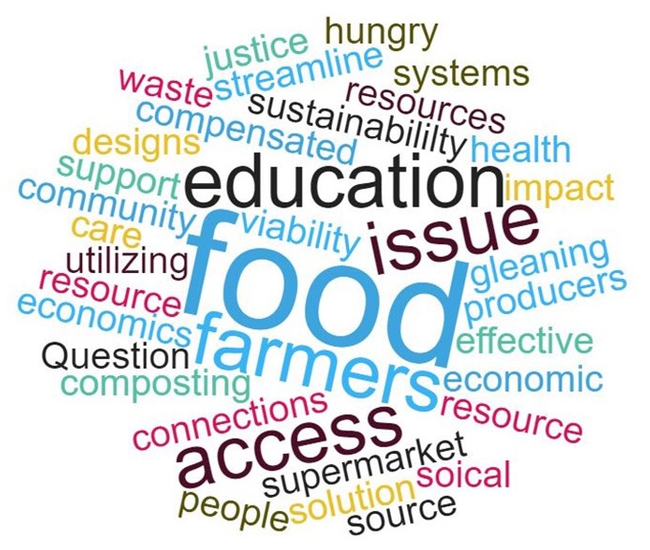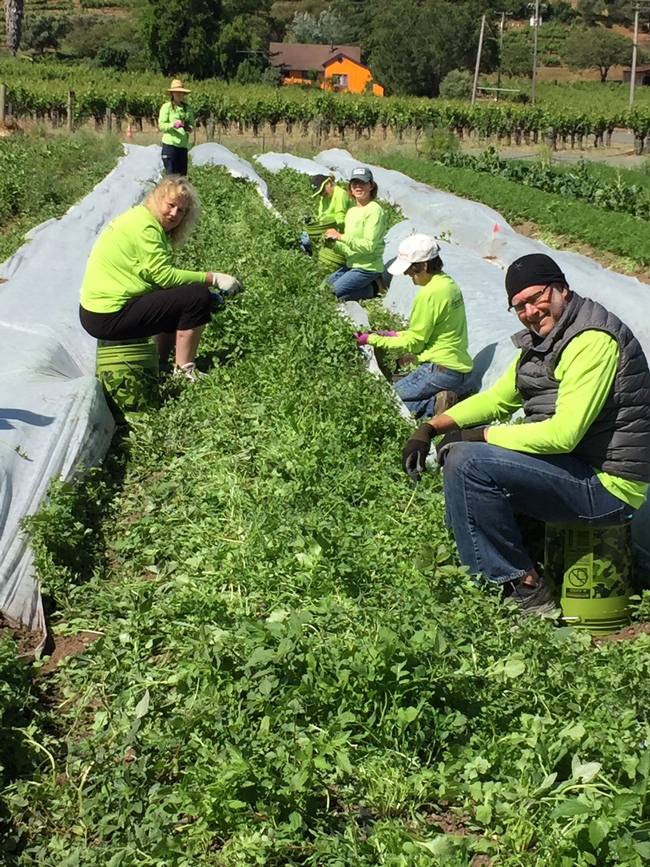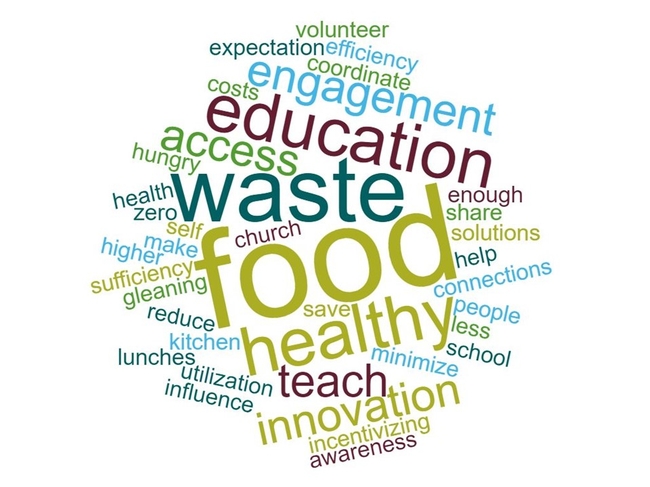Recently, the head of a local food pantry shared with me how grateful they were to receive a donation of several hundred pounds of fresh tomatoes from a local farmer; the tomatoes were snapped up by food pantry clients within an hour. However, he was also shown a picture of hundreds of pounds of tomatoes that had not been captured in time for donation; instead the tomatoes were sitting in a compost pile at the farm. In this case, at least the farmer was composting the wasted tomatoes, but this story demonstrates that significant opportunities exist here in Sonoma County to improve the rate of recovered food that would otherwise end up in compost piles, or worse, in our landfill.
| Food Recovery Forum |
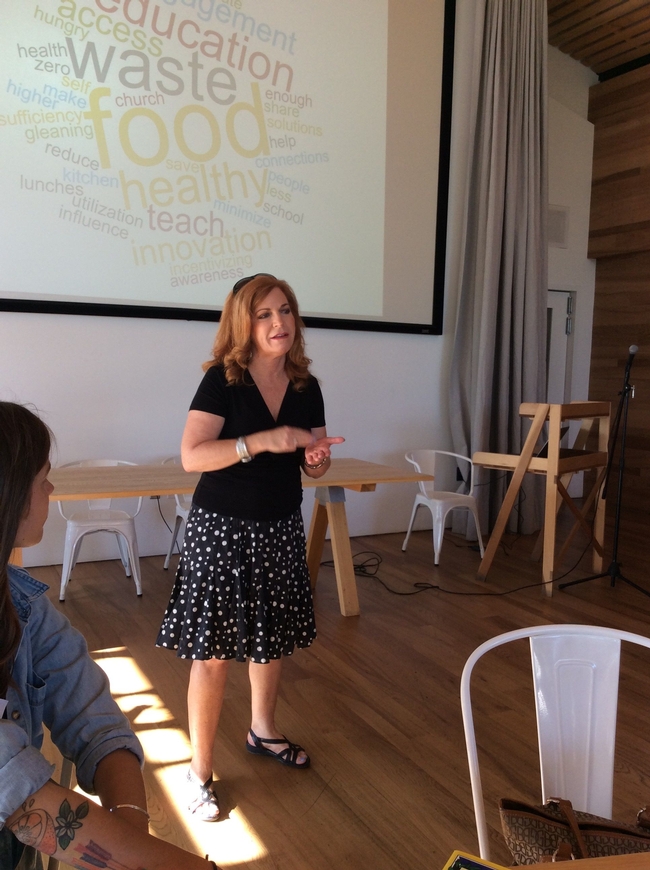 Supervisor Zane |
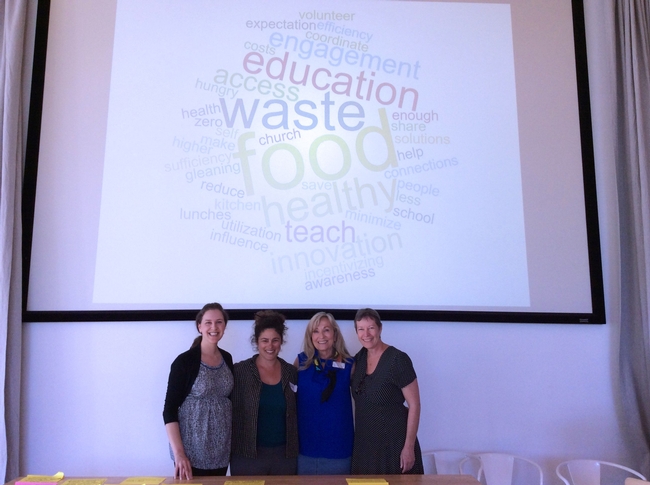 Julian van Soelen-Kim, Miriam Volat (facilitator), Stephanie Larson & Mimi Enright |
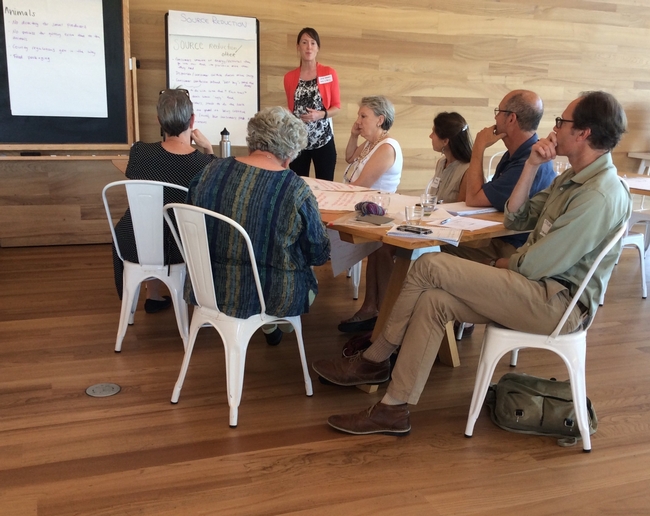 Breakout discussion |
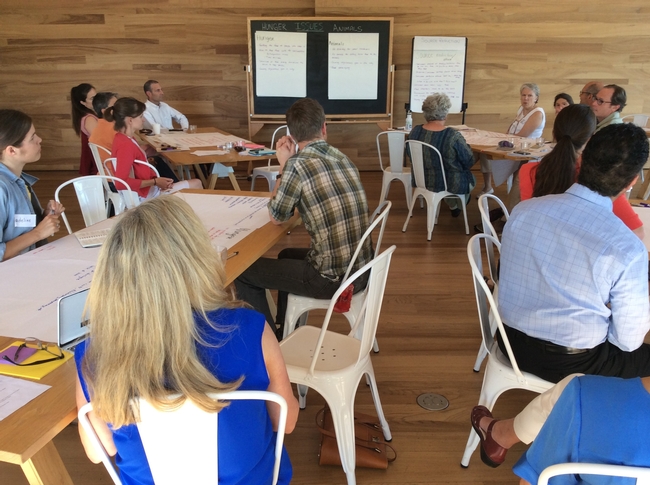 Breakout discussion |
Like many other counties, Sonoma County struggles with the dichotomy of people going hungry -- 82,000 missed meals per year as estimated by Redwood Empire Food Bank -- while over 45,000 tons of food ends up in our landfill (per the 2014 Sonoma County Waste Characterization study). In recognition of this issue nationwide, the USDA and EPA recently established the nation's first food waste reduction goals – a target of 50% reduction by 2030.
Nearly 40% of food goes uneaten in the U.S. today (National Inst. Of Diabetes & Digestive & Kidney Diseases, 2009). Consumers most likely represent the largest portion of food waste, with food service (hospitality in specific such as weddings and conferences) coming close behind, followed by farms and retail (supermarkets) (Dana Gunders, NRDC, 2015). Food waste comprises one of the single largest components of U.S. solid waste contributing to methane emissions.
Food scraps in our local landfill accounted for 30% of the total waste in 2010; the greenhouse gas (GHG) emissions for organic materials ending up in the landfill equate to 4% of the total Sonoma countywide GHG emissions (Climate Action 2020 report, July 2016). According to the Sonoma County Climate Action report, “increasing population and employment means more solid waste and associated GHG emissions in the future without further action. Strategies to reduce waste generation, increase waste diversion from landfills (such as through recycling and composting)…are therefore essential parts of CA2020.”
This data points out the local (and nationwide issue) of food waste and associated GHG emissions, but it doesn't reflect all of the resources that go into growing our food (chemicals, energy, land, water, labor, etc.) that are also wasted when food ends up in our landfills. About 10% of the U.S. energy budgetgoes to producing, distributing, processing, preparing & preserving the plants & animals we consume (Michael Webber, Scientific American, 2011). “Even the most sustainably farmed food does us no good if the food is never eaten” (Gunders, 2012).
Creative solutions in Sonoma County are already helping address the food waste issue, such as CropMobster, developed by Nick Pappadapolous, which provides a free on-line platform for connecting surplus from suppliers in our local food chain. Several gleaning organizations are operating in Sonoma County – working both with homeowners & farmers to harvest produce that would go to waste & connecting that food with people in need via food pantries & non-profits. Food recovery is occurring through faith-based organizations, food pantries, non-profits, and Redwood Empire Food Bank, but there is no overall coordinated effort to provide solutions to facilitate food waste reduction across the County.
Our current food recovery model is predominantly based on non-profits which run with volunteers; non-profit food recovery efforts are under resourced. We need to build to a collaborative approach in support of the non-profits operating in this space. We also need to educate food businesses about the myth of liability issues when they are donating food.
We need to set food recovery as a priority – especially in regards to getting food to people in need. Farmers have excess produce to share; caterers have prepared food left over after large events; gleaners are looking at the key question of “where does the food go”; and all represent an opportunity to keep food out of the landfill to feed hungry people or animals.
In June 2016, UCCE Sonoma hosted a Food Recovery Forum in partnership with Redwood Empire Food Bank, CropMobster and Shed. This event gathered a group of dedicated people dedicated to discuss current obstacles and possible solutions to this problem in Sonoma County. A small group of individuals has been continuing the dialog to develop some of the ideas generated at the Food Recovery Forum into solutions for Sonoma County. Some of the solutions that the “Food Recovery Coalition” is working on for presentation to the Sonoma County Board of Supervisors include:
- Map community resources: Create a County “landing portal” with directory & maps to resources in the food supply chain (specialty crops food producers, gleaners, grocery stores, restaurants, caterers, food pantries, pig farmers, compost facilities, etc.).
- Awareness campaign: Create a social & print media campaign to generate awareness of this issue (targeted at both consumer and business waste reduction).
- Mini-neighborhood hubs: Connect neighborhood resources such as community gardens, community kitchens, gleaners, food pantry, local chefs and farmers, business and schools, composting facilities to build smaller scale community connections for getting food that would go to waste to hungry people, animals or composting facilities.
- Expand gleaners' connections: Create a central resource of guidelines to support occasional gleaning by individuals/organizations.
- Pair farmers' markets with local non-profits: Pair each farmers' market with a local non-profit food redistribution organization.
- Cold storage network: Create a cold storage network for food recovery organizations for collection and preservation while it is waiting to be picked up by food distribution organizations.
- Liability education: Create a liability education campaign via the environmental health department to ensure that business understand the limited risks associated with food donation. Ensure there are no roadblocks for food donation in Sonoma County via a regulatory review.
- Infrastructure investment: Invest in food recovery infrastructure and capacity (as compared for example to composting and waste management infrastructure).
- Business incentives: Incentivize businesses to encourage more donations by creating a more robust food recovery system.
- Regional food recovery coordinators: Establish food recovery coordinators in each region of the County to build relationships and make connections for food recovery from farmers, grocery stores, restaurants, etc.
UCCE Sonoma recommends a countywide initiative to
create awareness of and generate solutions for
addressing the issue of food waste.
Food waste prevention can save natural resources, create jobs, alleviate hunger, conserve water, and reduce greenhouse gas emissions (ReFED report, 2016). A focus on initiatives aimed at reducing food waste in Sonoma County would also positively impact two of the Sonoma County climate action goals by increasing solid waste diversion and reducing emissions from the consumption of good and services, including food.
A countywide food recovery effort will help us reduce:
- GHG emissions associated with food waste in our landfill
- the state of hunger in Sonoma County
- the waste of the natural & human resources associated with
growing & distributing our food.
If you are interested in learning more or getting involved
please contact Mimi Enright menright@ucanr.edu 707-565-2880
Author - Program Manager, UC Master Gardener Program of Sonoma County & Community Food Systems
Attached Images:
